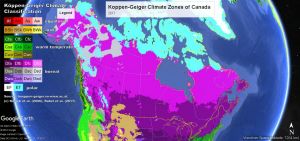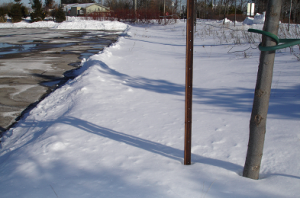Winter Management
Cold climates[edit]
Most major cities and urban areas in Ontario have a "humid continental" climate featuring snow and warm summers, classified as "Dfb" according to the Koppen-Geiger climate zone classification system, which includes average temperatures in the coldest month well below -3°C. Other locations in Canada with a humid continental "Dfb" climate include portions of the British Columbia interior (Kamloops, Kelowna, Prince George), the prairies (Calgary, Edmonton, Regina, Saskatoon and Winnipeg), southern Quebec (Montreal, Quebec City), and Atlantic provinces (Charlottetown, Fredericton, Halifax, St. John's). Locations in the United States with a "Dfb" climate include portions of Maine, Massachusetts, Michigan, Minnesota, New Hampshire, New York, North Dakota, Pennsylvania, Vermont and Wisconsin. Other locations around the world with a "Dfb" climate includes such cities as Oslo (Norway), Helsinki (Finland), Stockholm (Sweden), Moscow (Russia), Kiev (Ukraine) and Hokkaido and Sapporo (Japan).
The southernmost portion of Ontario has a humid continental climate that features snow and hot summers, with a Koppen-Geiger climate zone classification of "Dfa". Other locations with "Dfa" climate include northern portions of Illinois, Indiana, Iowa and Ohio in the United States.
De-icing salt[edit]
Sodium and chloride ions in de-icing salts applied to asphalt areas travel easily with the runoff water. De-icing salt can increase the mobility of some heavy metals in soil (e.g. lead, copper or cadmium). This may increase the downstream concentration of these metals [1][2]
Very few studies have sampled groundwater below infiltration facilities or roadside ditches receiving de-icing salt laden runoff have found concentrations of heavy metals that exceed drinking water standards [3][4]
To minimize risk of groundwater or soil contamination, the following management approaches are recommended [5], [6]:[edit]
Stormwater infiltration practices should not receive runoff from the following areas:
- Where large amounts of de-icing salts are applied (e.g., busy highways), or
- Pollution hot spots (e.g. vehicle fuelling, servicing or demolition areas, outdoor storage or handling areas for hazardous materials, and some heavy industry sites);
- Prioritize infiltration of runoff from source areas that are comparatively less contaminated such as roofs, low traffic roads and parking areas; and
- Apply pretreatment practices before infiltration of road or parking area runoff.
- Apply salt management best practices.
Cold climate considerations[edit]
Underdrains and flow control devices[edit]
Underdrain perforated pipes should be located below the frost line to reduce the threat of ice clogging. Ontario provincial standard drawings of frost penetration depth are available from the Ministry of Transportation as OPSD 3090.100 for northern Ontario [7] and OPSD 3090.101 for southern Ontario [8].
Weirs are generally less prone to clogging from ice than orifices under all flow conditions, proprietary low flow devices are also available which are designed to mitigate clogging from ice or other solid debris.
Plowing[edit]
Rubber plow blades are increasingly available and required in many jurisdictions. Their use reduces damage to all kinds of pavement surfaces and they are particularly recommended for application where LID facilities exist, such as permeable pavements and curb cut inlets of bioretention, bioswales, swales and stormwater tree trenches.
Rainwater harvesting[edit]
Freezing temperatures can cause problems with exposed collection pipes and portions of cisterns and pipes located above the foundation frost penetration depth. For standard drawings see Ontario Ministry of Transportation OPSD 3090.100 for northern Ontario, and OPSD 3090.101 for southern Ontario. Rainwater harvesting systems designed for year-round operation in cold climates like those in Ontario are typically limited to underground cisterns and outlet pipes located below the frost penetration depth, or cisterns integrated within buildings.
Green roofs[edit]
The survival of green roof plantings is greater in winters with long deep sub-zero temperatures. Being shallow and very exposed to warming sunlight, green roofs thaw rapidly. Frequent freeze-thaw cycles in the early and late winter are associated higher loss of vegetation on green roofs.
- ↑ Amrhein, C., Strong, J.E., and Mosher, P.A. 1992. Effect of de-icing salts on metal and organic matter mobilization in roadside soils. Environmental Science and Technology. Vol. 26, No. 4, pp. 703-709
- ↑ Bauske, B., Goetz, D. 1993. Effects of de-icing salts on heavy metal mobility. Acta Hydrochimica Hydrobiologica. Vol. 21. pp. 38-42., 1993).
- ↑ Howard, K.W.F. and Beck, P.J. 1993. Hydrogeochemical implications of groundwater contamination by road de-icing chemicals. Journal of Contaminant Hydrology. Vol. 12. pp. 245-268.
- ↑ Granato, G.E., Church, P.E., Stone, V.J. 1995. Mobilization of Major and Trace Constituents of Highway Runoff in Groundwater Potentially Caused by De-icing Chemical Migration. Transportation Research Record. No. 1483.
- ↑ Pitt, R., Clark, S., Field, R. 1999. Groundwater contamination potential from stormwater infiltration. Urban Water. Vol.1. pp.217-236. https://www.sciencedirect.com/science/article/abs/pii/S146207589900014X
- ↑ Toronto and Region Conservation Authority. 2009. Review of the Science and Practice of Stormwater Infiltration in Cold Climates. https://sustainabletechnologies.ca/app/uploads/2014/10/SW_Infiltration-Review_10.15.2014.pdf
- ↑ Ministry of Transportation. 2010. Foundation Frost Penetration Depths for Northern Ontario. OPSD 3090.100. Nov 2010. Rev.1. https://www.library.mto.gov.on.ca/SydneyPLUS/TechPubs/Portal/tp/opsViews.aspx
- ↑ Ministry of Transportation. 2010. Foundation Frost Penetration Depths for Southern Ontario. OPSD 3090.101. Nov 2010. Rev.1. https://www.library.mto.gov.on.ca/SydneyPLUS/TechPubs/Portal/tp/opsViews.aspx


